If you are making a checklist for kayaking or boating, a life jacket MUST be included along with your first aid kit and walkie-talkie. A life jacket literally can save your life in accidents. If you aren’t sure about life jackets, then we’ll try to explain about the best life jackets for kayaking and their necessity below. Hopefully, we’ll be able to convince you that a PFD (personal flotation device)is a worthy investment for boating.
After that, we’ll move to the meat of this buyer’s guide – our reviews of the best life jackets for kayaking, canoeing, and swimming! We’ll have a look at the features, pros, and cons of each of the selected life vests. Finally, to help you choose the right life jacket, we will talk about the key things to look for when shopping for a PFD. But first, of course, let’s try to understand the importance of a life jacket!

Why Is A Kayak Life Jacket Necessary?
To demonstrate the usefulness and necessity of a lifejacket when boating or kayaking, let’s have a look at a few interesting figures from the United States Coast Guard 2019 Recreational Boating Statistics.
Most relevantly to this post, where the cause of death was known, 79% of all fatal accident victims drowned. Of these, 86%were not wearing a life jacket. So it turns out that the vast majority of victims of fatal accidents haven’t been wearing a lifejacket in 2019!
To demonstrate that this wasn’t just a statistical anomaly in 2019, let’s also have a look at figures from previous years too.
- In 2018, 77% of victims of fatal accidents drowned, and 84% of them were not wearing a lifejacket.
- In 2017, 76% of fatal boating accidents drowned, and 84.5% of them were not wearing a life jacket.
- In 2016, 80% of victims drowned, and 83% of them were not wearing a life jacket.
So as you can see, the fatality rate from drowning along with the percentage of victims not wearing a life jacket has been more or less consistent throughout the years.
Furthermore, it would probably be safe to say that if the victims had been wearing a life jacket, they most likely would have survived. A life jacket would keep victims afloat even if they were unconscious, so when it comes to drowning, a life jackets a must-have on a kayak, canoe, or a motorboat.
If you are wondering how life jackets save lives, here’s how, according to the U.S. Coast Guard:
- By providing buoyancy in water if you accidentally fall overboard.
- By providing buoyancy when you jump into the water to save someone else.
- By providing buoyancy when you are no longer able to stay afloat yourself.
- By providing buoyancy for those who can’t swim or are too weak to swim.
Aside from safety in accidents, life jackets are great for people who are learning to swim. One of the biggest problems for learners is that they lack confidence – a life jacket can help with that.
Factors To Consider Before Purchasing A Life Jacket
When shopping for a life jacket, here are some of the things that you should consider:
- Size & fit. The life jacket should be sitting snugly on your body while not being too tight. Life jacket size is typically measured based on chest circumference and user weight.
- Adjustability. Your life jacket should be adjustable so that you can adapt it to your body shape.
- Ability to turn the wearer face up. Some life jackets are capable of turning an unconscious wearer face up. This feature is a must if you will not have access to help and if no one will be there to rescue you.
- Performance Level or Performance Type. Your life jacket should be appropriate for the activity that you will be participating in. We’ll have a look at life jacket Performance Levels and Performance Types below.
- Limitations of use. Some life jackets may only be approved for certain activities. Check what the intended applications of your life jacket are to avoid confusion and ensure your safety in the water.
- Color. Brighter colors like yellow or orange are optimal because they make the wearer more visible in the water.
- USCG approval. Ideally, your life jacket should be approved by the USCG.
The 10 Best Life Jackets For Kayaking, Fishing, Sailing, And Swimming
1. Stohlquist Rocker Personal Flotation Device
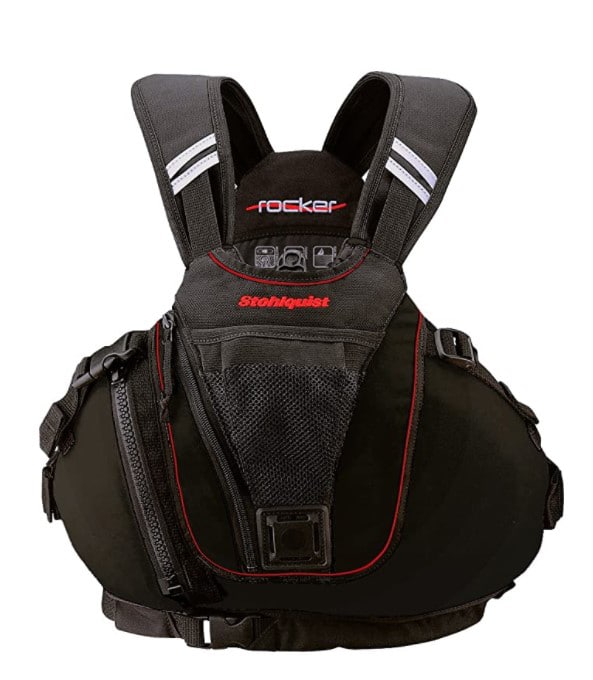
The Stohlquist Rocker PFD is an excellent choice if you want something higher-quality. This China-made life jacket is pretty functional, and it also offers a very sturdy build. The price is accordingly high, but you probably shouldn’t scrimp on quality in a life jacket. When it comes to features, what we particularly like about this life jacket is that it has a couple of zippered pockets. The pockets are compact and will only take small and thin items, but they are still nice to have if you want to keep your essentials nearby.
Aside from that, the Stohlquist Rocker life jacket has a D-ring that you may use to carry keys, a flashlight, a whistle, and not only. The comfort and support in the Stohlquist Rocker PFD are great as well. This life jacket features a cinch harness to ensure a snug fit, while the mesh back panel adds breathability and should keep you sweat-free.
The WRAPTURE torso is very cool too – it’s articulated and thus should conform to the shape of the wearer’s body. Thanks to this feature, Rocker appears to be a great option for women as well. In terms of materials, the Rocker PFD has a super-durable Cardura 500D outer shell and a 200D oxford liner. Heavy use and abuse shouldn’t be big challenges for this PFD.
Stohlquist offers 3 color options as well – black, Fireball Red, and yellow. We think that Fireball Red and yellow are optimal because of their higher visibility. Though even without the flashy colors, Rocker has good visibility thanks to its 3M reflective accents.
According to the Stohlquist website, the Rocker is approved by the USCG and is a Type III PFD. It’s also listed in the “Whitewater” section on the official website, so it should be nice for whitewater rafting.
One bummer about the Rocker is its shoulder straps aren’t adjustable, so you should make an effort to choose your size right. Given the price, this is slightly underwhelming.
Pros:
- Has zippered pockets plus a D-ring for small items.
- Excellent quality and durability.
- Great for women.
- Ventilated lumbar pad.
- 3 color options.
- USCG-approved.
Cons:
- Non-adjustable shoulder strap.
2. Onyx Kayak Fishing Life Jackets for Kayaking
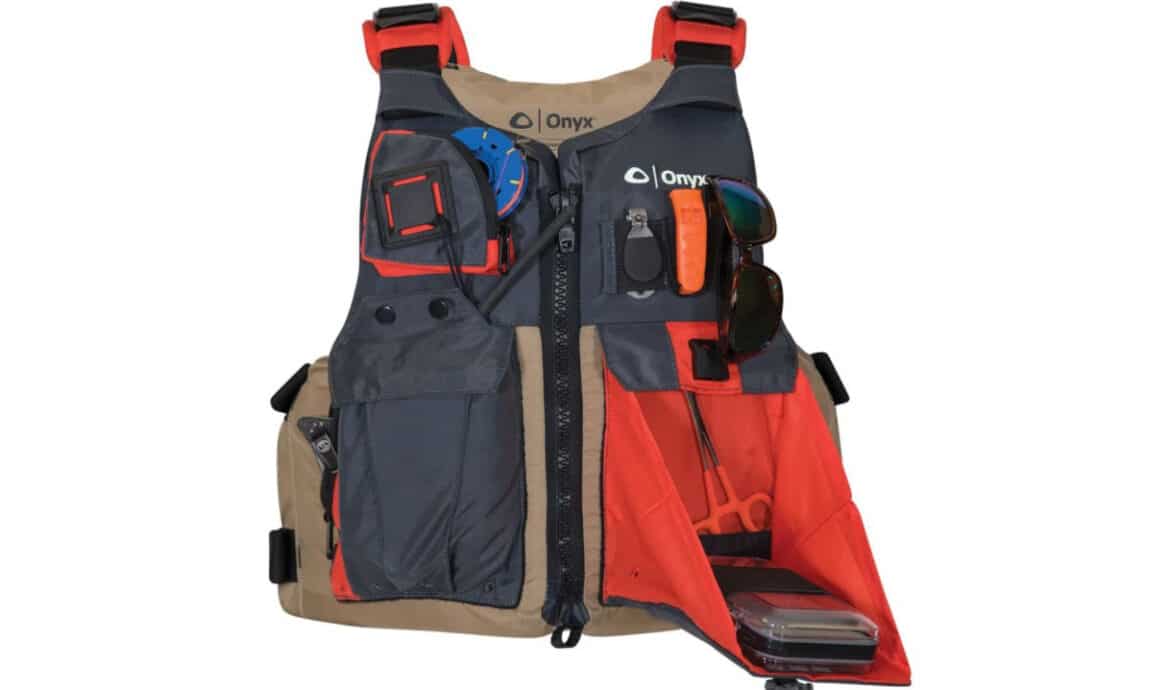
This life jacket from Onyx is designed specifically for kayak fishing. Not only that, but this is a very wallet-friendly life jacket that offers insane value for the money.
What we particularly like about this life jacket is how much space it has for personal items and accessories. The Onyx life jacket has several pretty roomy pockets that may be used for tools or walkie-talkies. The loops on the front left can hold items like sunglasses and car keys, while the lash tab on the right is wonderful for attaching flashlights or whatnot.
The one-size-fits-all design is remarkable too. Thanks to its 6 adjustment points, the Onyx life jacket can be adapted to the needs of most people. However, petite or very large wearers may find this life jacket inadequately sized.
This life jacket is a little bulky as well, and it may be uncomfortable for high-back kayak seats.
Overall, thanks to its storage space and customizability, this life jacket is an excellent choice for angling or other use cases where you need to have a lot of equipment on you. Considering the price, the Onyx PFD is an excellent purchase too, and its value for the buck is outstanding.
Pros:
- Inexpensive.
- 6 adjustment points for a comfy fit.
- Breathable mesh lower back area.
- Several pockets and accessory loops.
- USCG-approved.
Cons:
- Bulky and may be uncomfortable for high-back seats.
- The universal size may not fit petite or very large wearers.
3. Stohlquist Edge Life Jackets for Kayaking
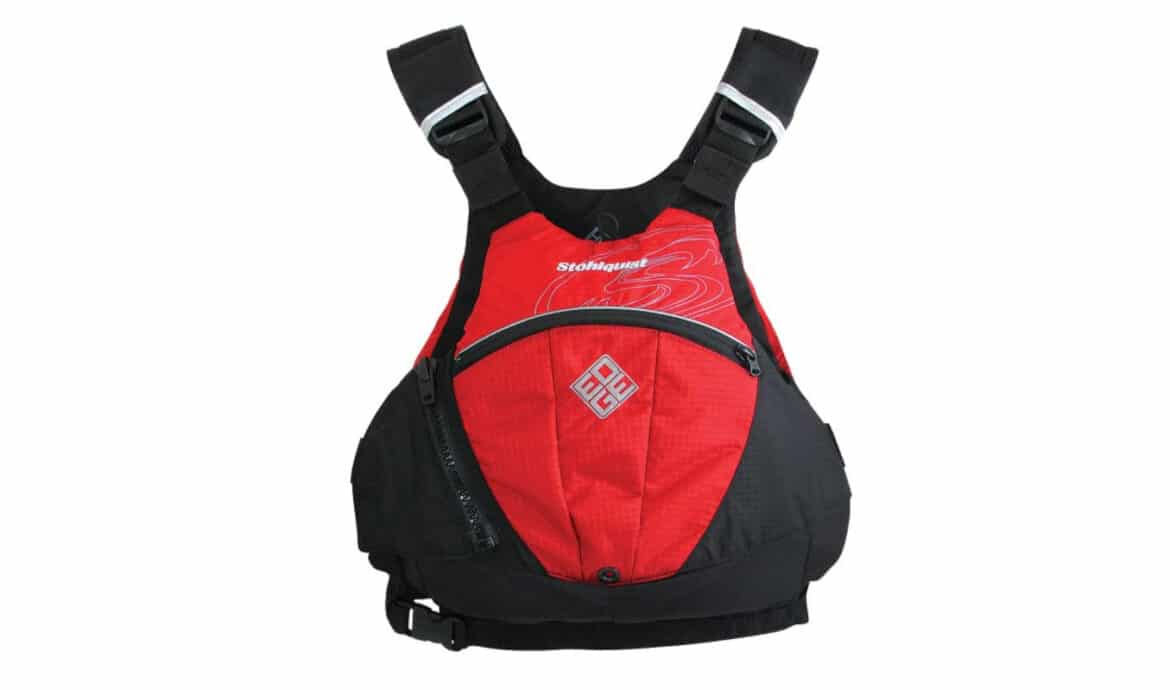
The Stohlquist Edge life jacket is a very nice alternative to the Rocker if you didn’t like the absence of the shoulder straps. In terms of materials, the Edge isn’t as tough as the Rocker PFD, but it perhaps will be more comfortable particularly for you.
Like the Rocker, Edge features a WRAPTURE torso with added ergonomics, while the mesh sides keep you cool on hot days. Thanks to the adjustable shoulder straps, the Edge PFD is easier to fit as well.
Now, when it comes to women, Edge isn’t the best for busty wearers – Rocker would be a better option. For others, this PFD is ergonomic enough and should fit perfectly as long as you choose your size correctly.
The Edge life jacket feels a little bulkier than Rocker as well, although the large arm openings still allow you to freely move your arms while paddling.
The Edge life jacket has a few pockets in the front too for small items. But it doesn’t have Rocker’s D-ring, so it won’t allow for as quick access to items like flashlights or keys.
Like the Rocker PFD, Edge has reflective 3M elements across its surface, and it also is available in red and blue colors for added visibility. We think that red will work better though since it’s a brighter color.
Lastly, the Edge life jacket is also approved by the USCG, and it is classified as Type III. It’s again designed for whitewater, but it could be used for general-purpose recreational boating as well.
Pros:
- Pretty durable.
- Ergonomic and comfy.
- Zippered front pockets.
- Mesh sides for added ventilation.
- USCG-approved.
Cons:
- Nothing to complain about.
4. Onyx Curve MOVEVENT PFD Life Jackets for Kayaking
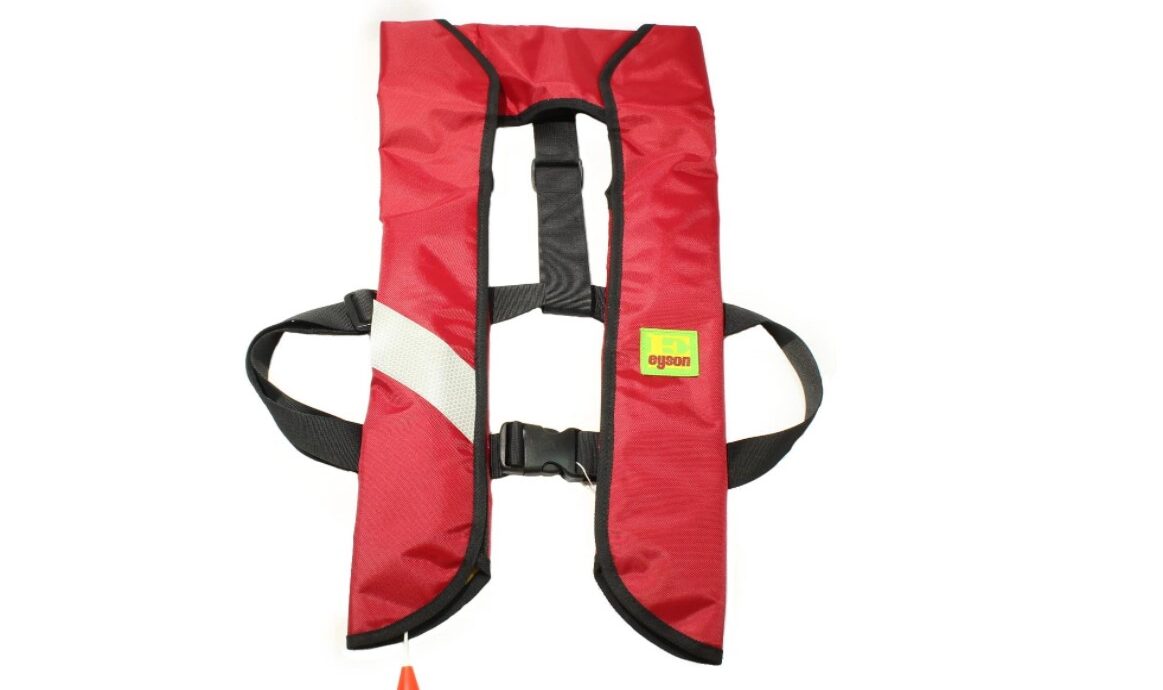
The Onyx Curve MOVEVENT life jacket is a nice option if you have a very limited budget. MOVEVENT is a nice alternative to the Onyx kayak fishing PFD we reviewed earlier too.
Needless to say, the quality in this PFD reflects the price, but if you don’t need the features of pricey PFDs or can’t afford them, this life jacket is a good choice.
As a Type III life jacket, Curve MOVEVENT is suitable for calm waters, and it is not designed to turn the wearer face up in the water. But compared to standard Type III life jackets, MOVEVENT feels fairly light, which might be a plus for some people.
For added comfort, the MOVEVENT PFD features mesh inserts in the front and a full mesh lower back. The abundance of mesh in this life jacket makes this arguably one of the most breathable life jackets out there.
The shoulder straps here are adjustable as well, allowing you to easily adapt the PFD to your body shape.
Available in blue or yellow and featuring SOLAS-grade reflective material, MOVEVENT has rather high visibility too.
When it comes to comfort though, MOVEVENT feels pretty bulky – its freedom of movement is certainly very far from what you get with Stohlquist Edge and Rocker.
Pros:
- Lightweight.
- Really inexpensive.
- Mesh in the front and back.
- Approved by the USCG.
Cons:
- The quality reflects the price.
- Bulky.
5. NRS cVest Mesh Back PFD Life Jackets for Kayaking
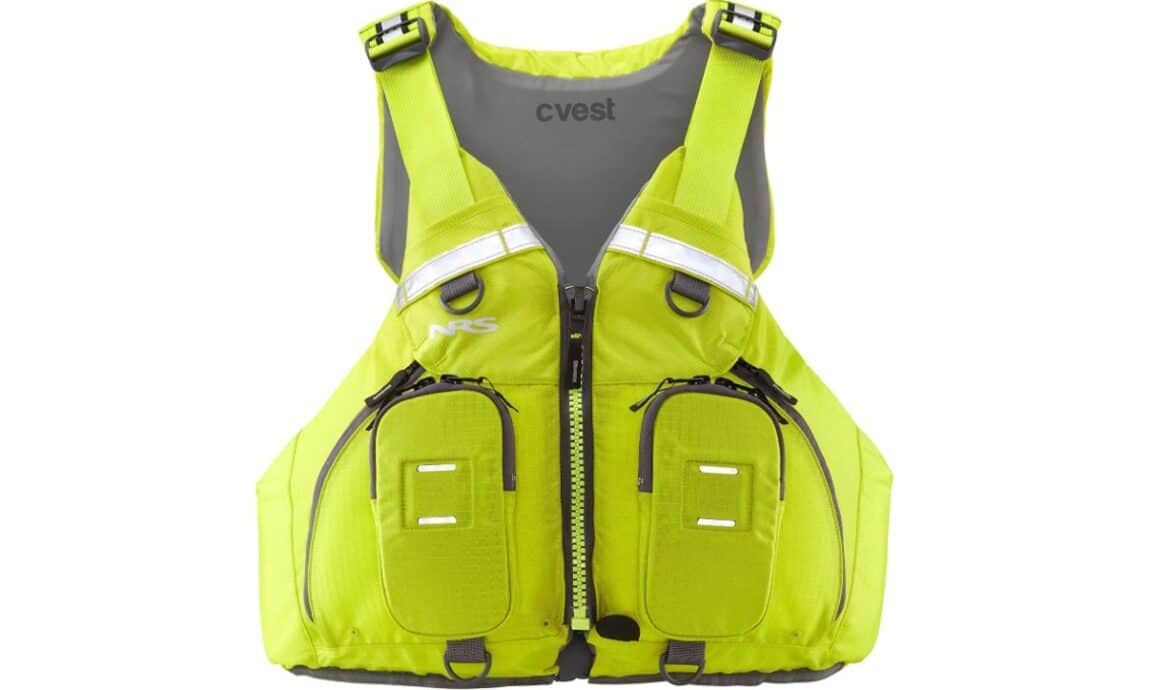
The NRS cVest PFD is an excellent choice if you want an adjustable life jacket that accommodates plenty of accessories.
Perhaps the greatest thing about this life jacket is how many spots it has for equipment. Boasting numerous D-rings, reflective patches on the upper back that double as attachment loops, and a pair of lash tabs, cVest offers pretty much endless opportunities for customization.
Comfort in cVest is great as well. This personal flotation device has 6 adjustment points–4 points on the side, plus the shoulder straps. The front-entry zipper makes putting the life jacket on a breeze too, while the wide arm openings make paddling very easy.
cVest can also boast excellent quality and durability. The 400D ripstop nylon outer shell will take abuse no problem, and the craftsmanship reflects the price of cVest as well (this is a fairly expensive life jacket).
The visibility in the cVest PFD is excellent too thanks to the vibrant red color with orange patches. The SOLAS reflective tape on the front adds fair share of visibility to this life jacket as well.
When it comes to certification, the cVest life jacket is approved by the USCG and is classified as Type III, like all our previous picks. With that, it’s a great pick for recreational paddling, but it won’t work for rough waters, and it will not turn unconscious wearers face up in the water.
Although perhaps not the very best life jacket on our list, NRS cVest is certainly a remarkable option. Unfortunately, a limited number of sizes were available as of this review’s writing, though with time, other sizes should get restocked.
Pros:
- Vibrant red color for high visibility.
- Has a pair of zippered pockets, D-rings, lash tabs, and more.
- Extremely durable.
- Very comfortable and widely adjustable.
- USCG-approved.
Cons:
- Limited number of sizes available as of this review.
6. Onyx MoveVent Dynamic Life Vest
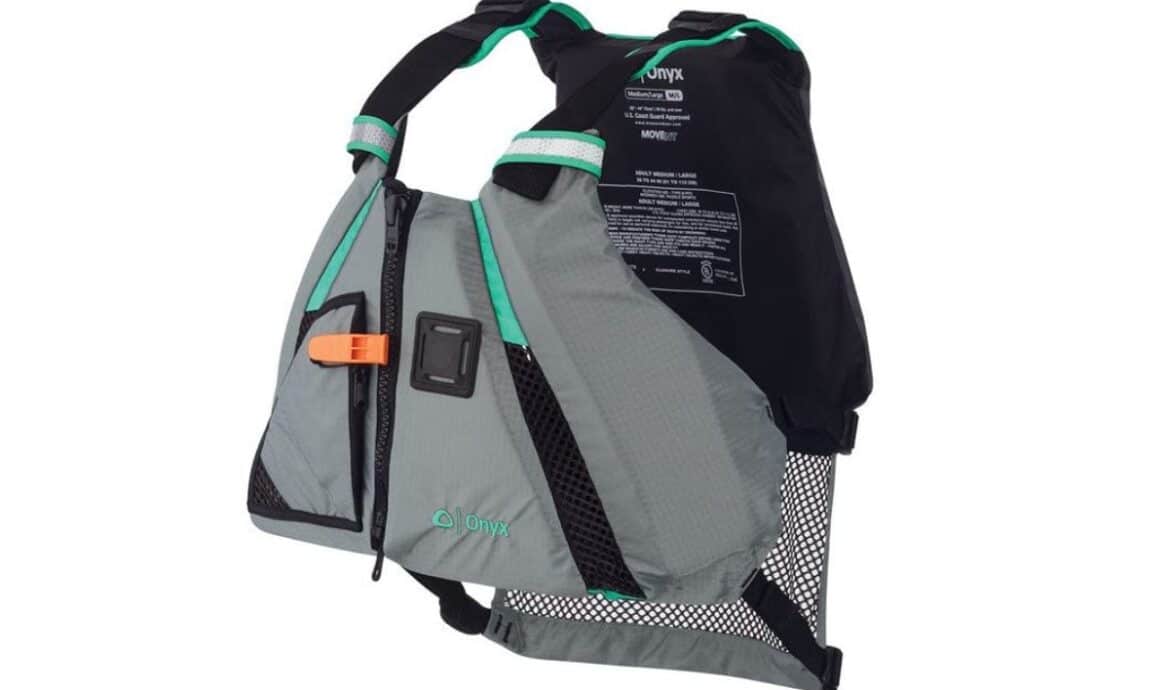
The Onyx MoveVent Dynamic is a slightly more advanced version of the Curve MOVEVENT life jacket reviewed earlier.
At the basics, the design here is the same. This is a fairly light life jacket that offers excellent ventilation. The quality and comfort here aren’t great, but they are nice for the price.
The main difference between this and previous MoveVent life jacket is that this model has one zippered pocket on the front right and a lash tab on the left. So when it comes to accessory or personal item storage, this MoveVent is clearly superior.
Other than that, the MoveVent Dynamic life vest is nearly identical to the Curve MOVEVENT life jacket reviewed earlier. It’s again a nice pick for limited budgets, but it’s better than the previous MOVEVENT life jacket if you want to have pockets for your items.
Pros:
- Light.
- Really inexpensive.
- Has pockets and accessory tabs.
- Mesh in the front and back.
- USCG-approved.
Cons:
- The quality reflects the price.
- Bulky.
7. O’Neill Men’s Reactor USCG Life Jackets for Kayaking
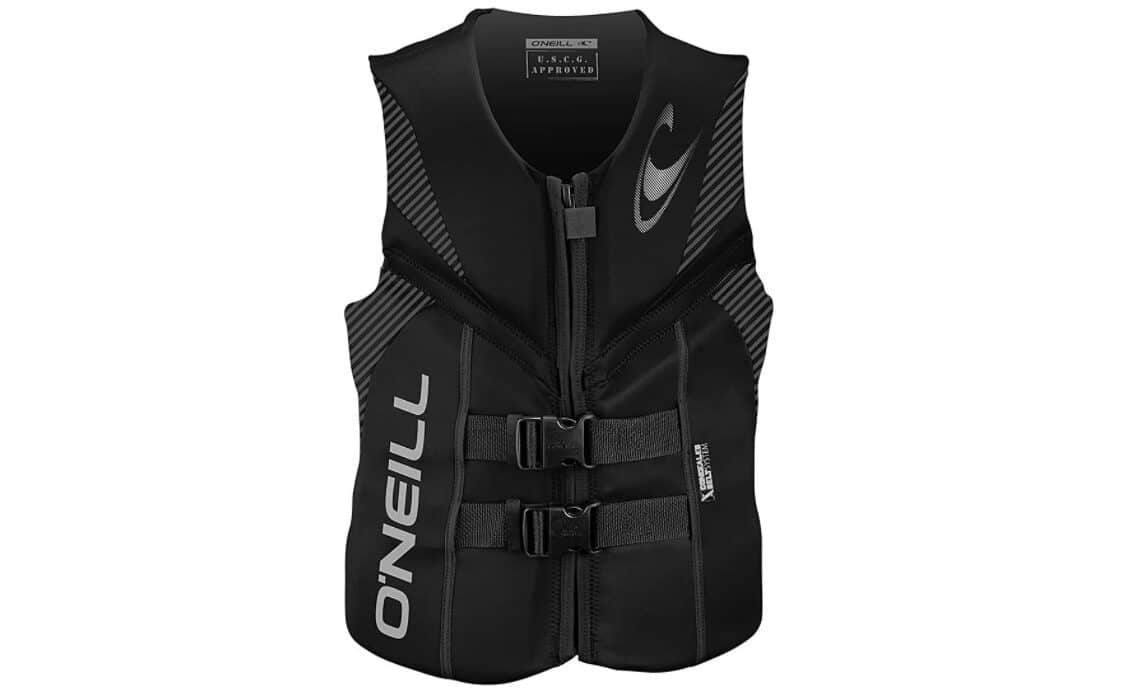
The Reactor life vest from O’Neill is an excellent choice if you want something comfy and high-quality.
The highlight of the Reactor PFD is its ergonomic and anatomical design. Featuring flex points in key areas along with segmented foam, the Reactor life jacket easily conforms to the shape of the wearer’s body and also minimally restricts movement. All in all, this is perhaps one of the most comfortable life jackets you can find on the market.
What’s also great about the Reactor life jacket is how securely it sits on the wearer. This is thanks to the pair of buckles in the front.
The quality in this life jacket is great as well, but it’s expectable at this price point.
Reactor is approved by the USCG and is a Type III life jacket too, so it’s suitable for most use cases in calm waters.
Overall, O’Neill Reactor is an excellent buy for the money, but it has two issues. First up, the colors here are pretty dark, which may negatively impact visibility. The black color scheme with patches of blue/grey/red looks really cool, but the visibility may suffer.
Reactor doesn’t have pockets or accessory loops too. This isn’t that big of a deal, but the absence of storage space for items may be a dealbreaker for some buyers.
Pros:
- Approved by the USCG.
- Sits on the wearer very securely.
- Comfy and doesn’t restrict movement.
- Great quality.
Cons:
- The color schemes of this life jacket are dark and have low visibility.
- Doesn’t have any pockets, unlike many other comparably-priced PFDs.
8. Stearns Child Classic Series Life Jackets for Kayaking
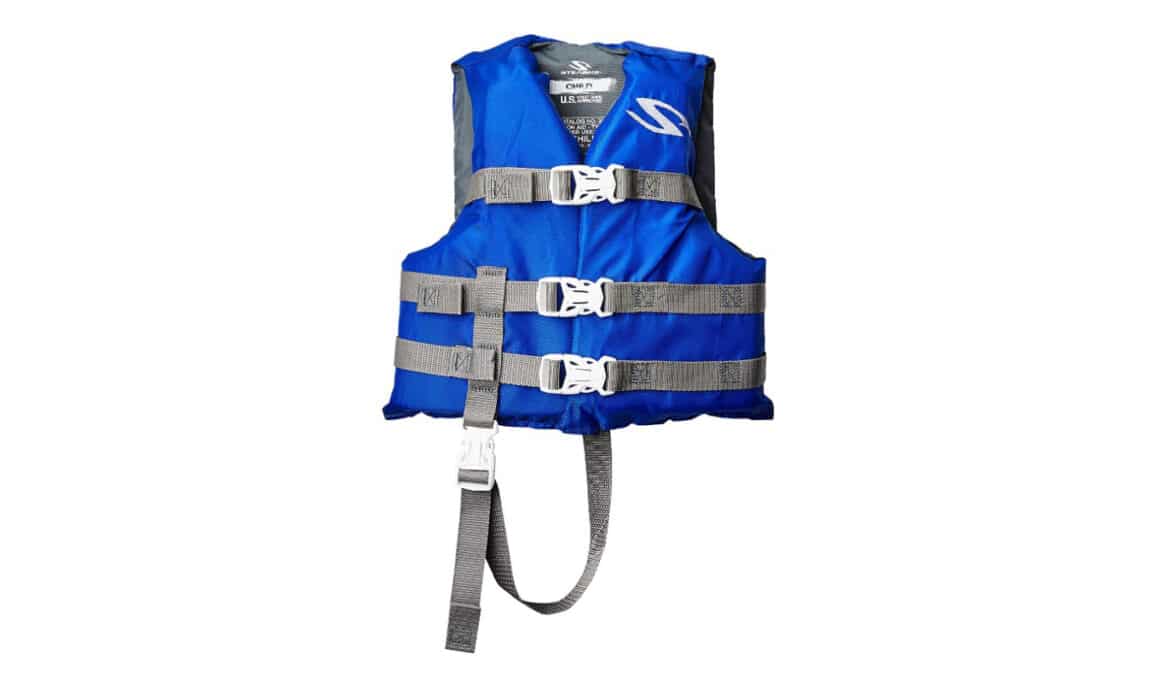
If you are looking for a kid’s life jacket, then this life vest from Stearns is an excellent choice. This life jacket is exceptionally inexpensive yet offers all the essentials to keep children safe in the water.
The highlight of the Stearns life jacket is its safety. It features 3 adjustable buckles in the front to make sure that it doesn’t come off, and there also is a leg strap for additional safety. Though you should keep an eye on your child at all times while they are in the water, the leg strap + 3 buckles are very nice.
The Stearns life jacket is also available in red and blue. We think that the red color is a better choice since it offers better visibility.
This life jacket is USCG-approved as well, so it has adequate quality and safety for children.
Pros:
- Great for children.
- 3 adjustable buckles and a leg strap for safety.
- USCG-approved.
Cons:
- May run small.
9. Eyson Slim Inflatable PFD Life Jackets for Kayaking
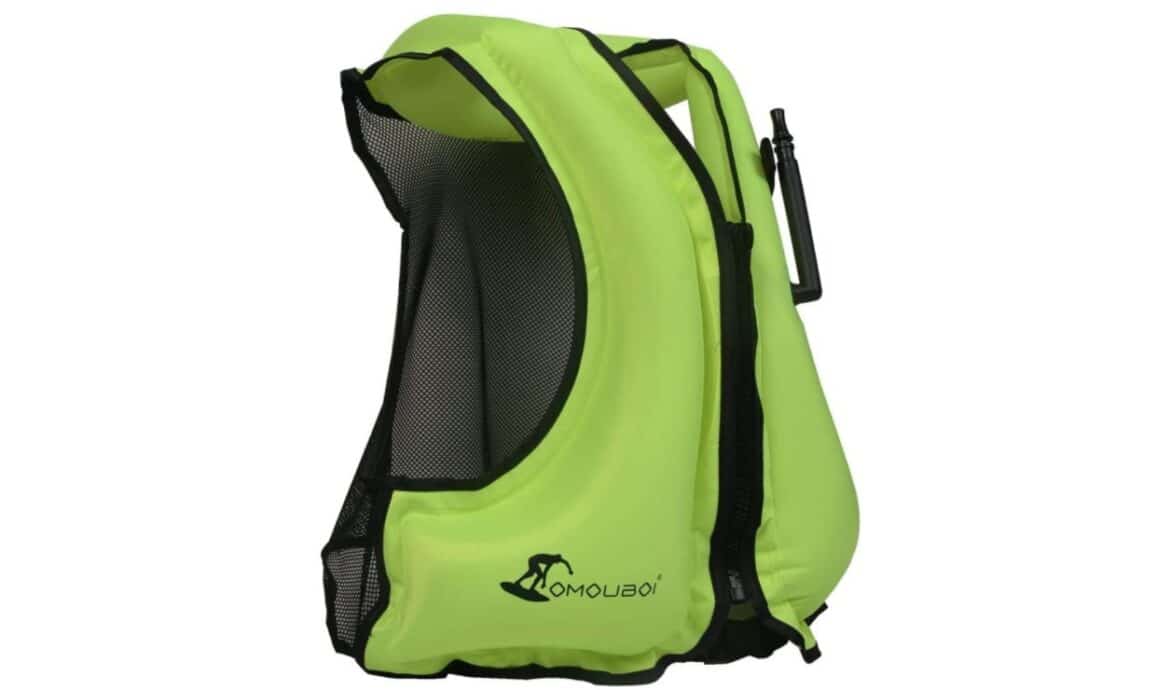
As an inflatable PFD, Eyson Slim is very light and compact when deflated. If you don’t like how traditional life jackets feel on your torso, then something like the Slim life jacket might be excellent for you.
This particular version of Eyson Slim only has manual inflation – you need to pull the handle on the jacket to inflate it. It takes only about 2-3 seconds for the PFD to get fully pumped up, so the manual inflation isn’t a big downside. The PFD is also advertised to stay buoyant for over 48 hours, with the buoyancy loss after 24 hours being only 5%.
There is also an automatic variant of this life jacket if you want it, but if your budget is tight, this one is also fine.
In terms of fit, this PFD boasts a one-size-fits-all design. The adjustable buckles should make this thing work for most people, although needless to say, you are going to be more comfortable with a life jacket that’s sized just right for you.
Remarkably, this inflatable life jacket has high buoyancy –150 Newtons, so it works for adults weighing up to 330 pounds. This should be more than enough for the vast majority of buyers.
Since this is an inflatable PFDs, you might also be worried about punctures. Well, the polyester oxford cover is reasonably tear- and puncture-resistant, but you should obviously take good care of it since it’s not indestructible.
Lastly, for added visibility, this life jacket features SOLAS-approved 3M reflectors.
Pros:
- Inflatable.
- Very light and compact when deflated.
- Universal, one-size-fits-all design.
- Pretty buoyant – suitable for up to 330-pound wearers.
- D-ring for accessories.
Cons:
- No automatic inflation – requires that you pull a handle.
10. Eyson Slim Auto Inflatable PFD Life Jackets for Kayaking
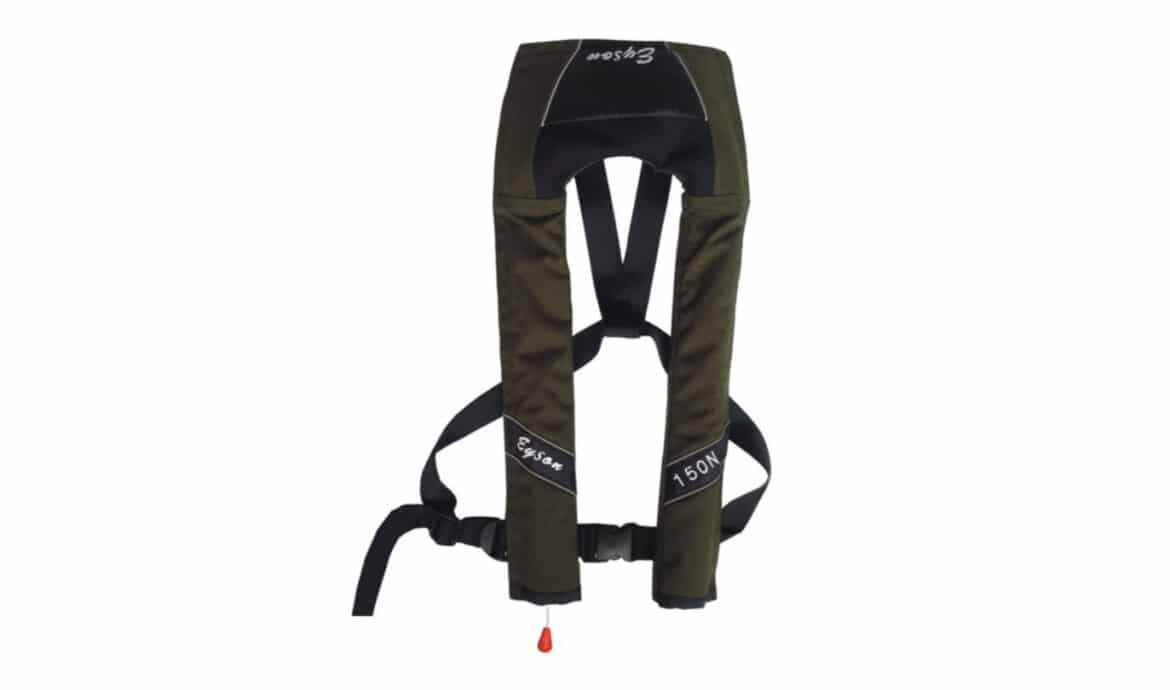
Finally, we have this inflatable PFD from Eyson. Although this life jacket seems identical to the Eyson inflatable PFD we’ve just reviewed, it has one huge difference.
When submerged in water, this PFD model inflates automatically with no action on your part. However, you may also manually inflate the PFD – just like the previous Eyson life jacket.
The automatic inflation may seem minor, but it makes the PFD more convenient and also translates to added safety. In cases where you are unable to inflate the life jacket on your own, automatic inflation may literally save your life.
Other than the automatic inflation, what also differs in this life jacket is the color – it’s red and thus should have better visibility in the water. But if you look around, you should be able to find a red version of the manual PFD too.
As for the rest, this life jacket is identical to the previous Eyson model. It has a puncture-resistant design, universal sizing, as well as high buoyancy. If you think that the automatic inflation is worth the investment, this PFD definitely is a good purchase.
Pros:
- Inflatable.
- Very light and compact.
- May be inflated manually or automatically.
- Universal sizing.
- Pretty buoyant – suitable for up to 330-pound wearers.
- D-ring for accessories.
Cons:
- Nothing to complain about.
You may also will be interested to know about the best water shoes for kayaking and the best kayak fish finder reviews.
Lets sea A Quick video review on Best Life Jackets for Kayaking.
The Differences Between A Life Jacket for Kayaking And Life Vest for Kayaking
Life vests and life jackets are nearly identical in practice, so one could say that there are no differences between the two safety device types. To determine how a life jacket will perform in the water, you should have a look at its Performance Level or Performance Type rather than at the name it is sold under.
The same could be said for the life jacket vs PFD (personal flotation device) comparison, but more often than not, PFDs:
- Have lower buoyancy.
- Have limited turning capability.
- Are smaller and lighter.
All in all, a PFD would be more suitable for calmer waters and closer to the shore. However, again, don’t forget to check the performance rating of the life jacket before buying it.
Laws And U.S. Coast Guard Safety Ratings
If you didn’t know that life jacket safety is regulated by state laws, then well, you should know that. The United States Coast Guard provides a breakdown of laws state-by-state on its website. You should check the state law guide for reference, but do more research too since we aren’t sure how frequently the USCG updates the table.
As a general rule, life jackets are required on vessels, but the required type of life jacket and age limitations may vary from state to state. No matter what, failure to comply with state law may incur a fine. Each state has its own set of fines, so you should have a look at these as well.
When it comes to the law, it’s also important to be able to distinguish between safety ratings. The USCG has two ratings that you should know about – Performance Type and Performance Level.
By Performance Type, life jackets are categorized as follows:
- Type I – These life jackets have the highest inherent buoyancy and are capable of turning most unconscious people in water face up. Type 1 – life jackets keep the wearer vertical and slightly backward in the water.
- Type 2 – Type II life jackets can turn some unconscious wearers face up.
- Type 3 – These life jackets are designed to help a conscious wearer maintain an upright position in the water. Some Type III life jackets may also be able to turn wearers face up.
- Type V. Type V life jackets are approved for a limited list of activities such as boardsailing or whitewater rafting. The label of Type V life jackets indicates which applications the jacket is suitable for.
As for Performance Level, life jackets can be:
- Level 50.These life jackets are intended for competent swimmers, those who are near the shore, or those who may be rescued by someone nearby should they need assistance.
- Level 70.Level 70 lifejackets are designed for those who are near the shore or those who have access to means of rescue. Note that in disturbed water, these life jackets can’t be expected to keep the user afloat for a long time.
- Level 100.Level 100 lifejackets are suitable for situations where you may have to wait for rescue in sheltered water. Rough water is too much for these life jackets.
- Level 150.This level of life jackets is intended for general application, and it may also be used with foul-weather clothing. Level 150 life jackets can turn the wearer face up and help them maintain that position.
- Level 275.These life jackets are typically used offshore or in extreme conditions.
The number in the Performance Level rating indicates the minimum buoyancy of the life jacket measured in Newtons (N). Newton is a metric unit chosen for consistency with European and Canadian standards.
Needless to say, you should choose a life jacket based on your needs. Always check the label of the life jacket to figure out when it should and should not be used.
Summary
A life jacket is a must if you want to keep yourself and your companions safe while on the water. Let’s not forget that over 80% of people who drowned in recent years were not wearing a life jacket. Had they been wearing a life jacket, they most likely would have survived.
Aside from that, life jackets may be required in some states. If you are caught without a life jacket, you will most likely be fined.
In the end, follow our recommendations and tips, and you should be able to choose the best life jacket without much effort.

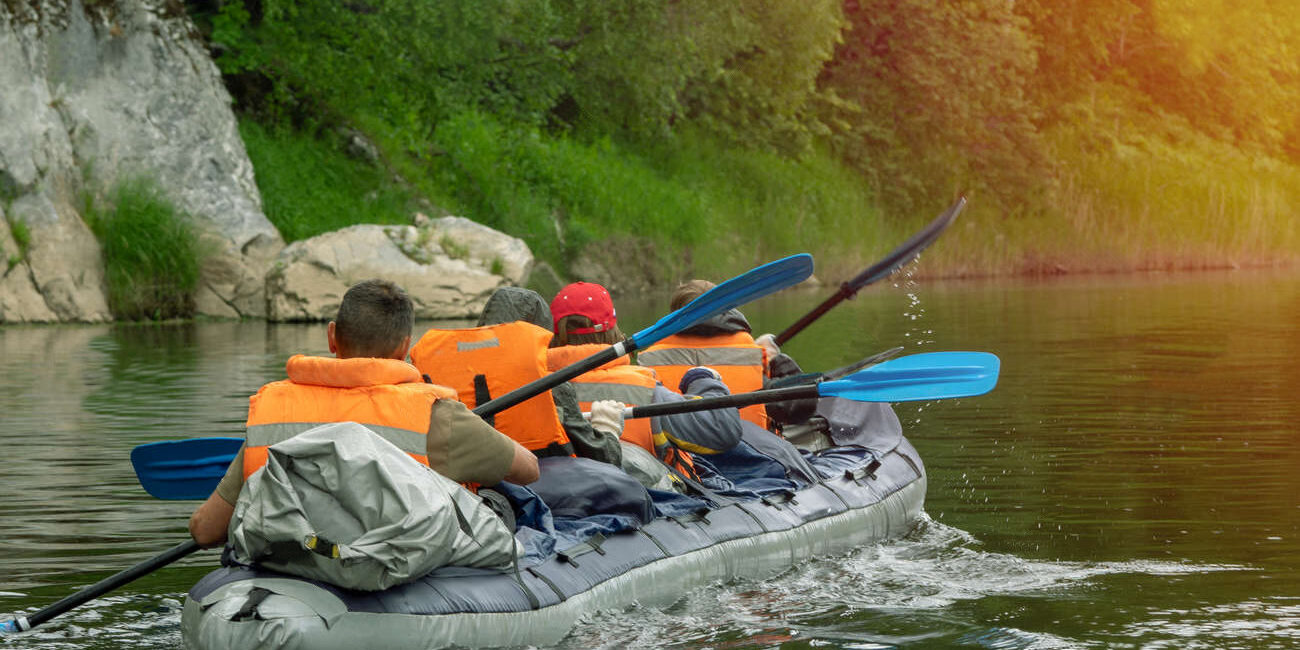






10 Comments